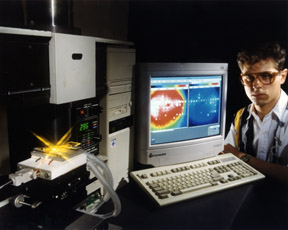 |
|
|
|
|
|
|
|
|
|
|
|
 |
The flood of potential new targets coming from genomics is raising the stakes for researchers, placing even greater emphasis on speed and competition. Researchers relying only on traditional wet-lab or clinical approaches for making decisions or setting priorities are likely to find themselves outpaced by those who combine empirical methods with computational models of cells, molecular pathways, or more complex biological systems. These models do not have to be entirely accurate to provide useful insight or to bias the selection of targets or approaches in favor of those more likely to be productive. Given the enormous increase in genetic and molecular data, such models will continue to improve and are predicted to become an essential tool for evaluating hypotheses, with only the more promising ones being subjected to empirical testing.
|
 MUTUALISM : wet lab & insilico lab
MUTUALISM : wet lab & insilico lab
|
METABOLIC PROFILING : AN INTEGRATION OF ANALYTICAL AND INFORMATICS TECHNOLOGIES :
Metabolic profiling is an emerging science in which the metabolic status of a tissue is assessed in terms of the overall balance of metabolic pools (or metabolome) in that tissue. The information that is derivable from the metabolome is very different from that of the genome or transcriptome in that each of these levels corresponds to a very different perspective on cellular reality. Just as the genome may be understood to represent function" and the transcriptome may represent "functional response," the metabolome represents the base reality of cellular function. Therefore, the goal of metabolic profiling is to understand a tissue in terms of the functional capacity of its metabolic pathways. The techniques of metabolic profiling rely on the ability to measure the concentrations of a large number of biochemical intermediates. Of necessity, these measurements are not quantitative and are useful only in the context of a comparison with other tissues. For these reasons, the integration of the measuring technologies, usually some form of mass spectral data, with a variety of statistical and computational systems is a fundamental requirement
|
 DECIPHERING THE SECRET BANDS OF LIFE !
DECIPHERING THE SECRET BANDS OF LIFE !
|
METHODS OF AUTO REGULATION IN BIOLOGICAL SYSTEMS - EXAMPLES AND IMPLICATIONS FOR MODELLING :
Autoregulation and homeostasis are the terms often used by biologists to describe the state of invariable biochemical milieu found in quiescent cells or the mechanisms of achieving such a state. Quiescent state can also be often described as the state of "a cogged gun" at the ready to respond, often with great sensitivity, to incoming signals. The ways that a healthy cell can maintain this stable yet sensitive state through the use of relatively simple regulatory mechanisms will be described. Particular emphasis will be placed on the recurrent use of negative and positive feedback and biphasic regulation in biomolecular circuits. A wider aspect of autoregulation in which connections between modules constituting a larger biomolecular interaction network lead to coordinated response behavior of the cell in a resting and activated state will also be explored. Possible implications of aberrant autoregulation mechanisms for cell pathology will be covered. Throughout the talk an emphasis will be placed on analogies between the systems engineering approaches to design of complex devices and mechanisms underlying biological regulation.
A SYSTEMS APPROACH TO POST - GENOMIC THERAPEUTIC RESEARCH :
Integrated analysis of genetic, phenotypic, and chemical data will be required to gain insight into complex diseases, discover novel drugs, and integrate diagnostics with treatments for individualized therapies. Recent progress in molecular biology, measurement technologies, and computational performance is making it possible to approach these challenges from a systems perspective. We must now develop flexible computational methods for discovering predictive connections between genes, phenotypes, and drugs. These relationships involve complex nonlinear and combinatorial interactions, which cannot be found using traditional linear inference. We are currently applying our advanced data-mining and modeling procedures to :
(a) predictions in the areas of drug efficacy, genetic predispositions, diagnostics, and toxicology;
(b) network reverse engineering and in silico experimentation; and
(c) systematic experimental design to provide the right set of facts that permit accurate analysis.
|
|
----------------------------------------------------------------------------------------------------------
|
GENE THERAPY - A BRIEF INSIGHT
Gene therapy is defined as the use of a genetic material to treat a disease. It comprises strategies to repalce defective genes / DNA or add new genes to cells and tissues, and is being developed for application in the treatment of cancer, correction of metabolic disorders (Alzihmer's disease) and in the field of immunotherapy.
LINKS TO DEGREE PROGRAMS IN BIOINFORMATICS.
BEST SOURCE FOR ONLINE JOURNAL
|
 GENE THERAPY - TRENDS OF A BIOMOLECULE
GENE THERAPY - TRENDS OF A BIOMOLECULE
|
|